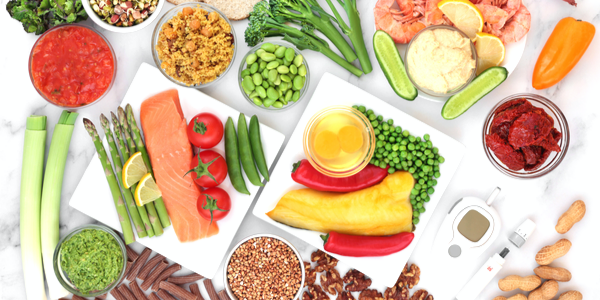
Ask most people about the main driver of the obesity epidemic and they will say something along the lines of overconsuming energy and exercising too little. While they are not completely wrong, this energy balance concept is an oversimplified explanation.
As of late, a new model called the carbohydrate-insulin model (CIM) discusses why and how a specific physiological mechanism involving high glycemic carbs and insulin encourages fat accumulation. This is majorly important as it poses implications for the most effective way to treat obesity.
Have a look at the top takeaways of the CIM concept!
The Energy Balance Model
First, it's important to understand the most accepted paradigm that attempts to explain the main driver of obesity.
Much research shows that body weight is regulated by complex, interconnected systems involving multiple hormones, organs, and metabolic pathways. In addition, recall that genetics account for about 20% of weight status.
Currently, two main models address the environmental causes of obesity. The most prominent model known as the energy balance model (EBM) states that energy-dense, palatable, modern processed foods lead to positive energy balance (weight gain) through increased intake of these foods. This is compounded by the sedentary nature of modern society.
Under this model, obesity management relies on energy balance - i.e. eating less and moving more. It typically also includes behavioral strategies to help people reduce the tasty processed foods and "manage" hunger.
The EBM, therefore, considers that all calories and macronutrients are created equally for practical purposes. Meaning, two different people eating the same amount of calories but completely different foods should both lose weight as long as calorie restriction is present.
The main critique of this model is that no interventional studies in humans have demonstrated a causal relationship between the palatability of foods and obesity, even when controlling for confounding factors. In fact, palatability is modifiable and influenced by the physiological state in the presence of these foods that are generally also energy-dense and higher in sugar, saturated fat, and sodium.
All in all, the EBM reduces body fat accumulation by eating more than one burns without accounting for the metabolic implications of different macronutrients. This is problematic because the model bypasses any explanation regarding environmental changes that have dysregulated biological mechanisms that resist weight change.
In other words, it does not explain why the popular set point theory has rapidly increased among genetically stable populations.
What Is the Carbohydrate-Insulin Model?
Touted as an alternative paradigm, the CIM proposes that fat accumulation or weight gain results due to the hormonal responses of a high-glycemic-load diet. The CIM purports that rapidly digestible carbs and their effects on insulin and other hormones cause increased fat deposition, and therefore drive the positive energy balance.
In simplistic terms, CIM exclaims that changes in food quality spur weight gain. According to the model, hormonal and metabolic responses to the specific source of calories, not just total caloric amount, is the first trigger in the mechanistic pathway of weight gain. This is essentially a reverse causal direction compared to the EBM. Under this notion, a shift in macronutrient use that favors fat storage then drives positive energy balance.
CIM & the Glycemic Index
A major premise of this model revolves around the concept of the glycemic index (GI). Glycemic index measures how much certain carbohydrate foods raise postprandial (after a meal) glucose levels.
High glycemic index foods include processed grains, potato products, and simple sugars. Low glycemic carbohydrate foods include fruits, vegetables, legumes, nuts, and unprocessed whole grains. Pure fat and/or protein sources exert little to no glycemic index.
High glycemic foods cause a rapid secretion of insulin, suppression of glucagon, and elicit a metabolic response that promotes an anabolic state for hours after a meal. This leads to avid uptake of glucose in muscles, liver, and fat tissue and stimulates lipogenesis (making bigger fat cells) in the liver and fat tissue.
What's more, this unique hormonal response keeps the body in an anabolic state (build and store) and nearly prevents the release of fuel substrates for cells. The brain perceives this as cellular starvation and induces hormonal mechanisms that then drive the desire for more high glycemic foods. It's also been proposed that this perceived state of cellular starvation reduces energy expenditure, muscular efficiency, and thyroid hormone activity.
Additionally, due to the reverse causal nature of this model, it also accounts for how variables - such as total food composition, meal timing, circadian rhythm, and environmental exposures - may affect body weight and food intake. This is through associated mechanisms like chronic inflammation, which reduces gut microbiome and muscle insulin resistance.
Due to the underlying physiological mechanisms that occur with high consumption of high glycemic foods, treatment for weight loss would focus on processed carbohydrate reduction. It would also increase the intake of lean proteins, healthy fats, and high-fiber, low glycemic carbohydrates. In other words, the quality and not the quantity of food would be the main focus.
This model proposes that in doing so, insulin secretion would decrease and fat burning would increase, which both result in lower spontaneous food intake. No longer would behavior techniques to reduce total food intake be the focus. The problem has less to do with willpower and knowledge deficits and more to do with adaptive physiological mechanisms to specific macronutrients.
CIM Recap
In summary, it is highly plausible that this model is more viable than the previous EBM. Countless people who are trying to lose weight and seemingly doing the right things by eating less and moving more still have major trouble. Perhaps it's because their insulin resistance is preventing any weight loss.
Indeed, reversing insulin resistance through a low glycemic diet (i.e. lower carb and higher fat and protein) would help create an environment for effective weight loss by actually targeting the physiological mechanisms of weight regulation at play. It would likewise help people with diabetes manage blood sugars and lower the risk of type 2 diabetes.
A Carbohydrate-Insulin Model Diet
In short, a carb-insulin model diet is low glycemic in nature. It prioritizes high-quality lean proteins and healthy fats and some high-fiber carbohydrates and limits high glycemic carbs like refined grains, added sugars, and sugary drinks. The fiber content in fruits, vegetables, beans, and legumes and unrefined whole grains slows the secretion of insulin and absorption of glucose, deeming them low glycemic carbs.
The most extreme version of a low glycemic diet is the infamous ketogenic diet. A true ketogenic diet reduces carb consumption to 20-50 grams of total carb/day. For reference, one apple includes 15 grams of carbohydrates, and many people need to stick to the 20 grams to remain in ketosis, at least at first. It's highly restrictive, but can be extremely effective at completely reversing insulin resistance.
At the other end of the spectrum is lower-carb diets that are typically restricted to 75-100 grams of carbohydrates. This is likely a much more sustainable approach and allows for a much higher intake of beneficial plant foods. Some people may need to restrict carbs more strictly at first before moving into a more liberal version of low carbs. However, some people likely need to remain on a pretty low-carb diet most of the time to keep insulin levels in check.
It should also be mentioned that portion moderation is still a cornerstone of any type of dietary pattern. Luckily, reversing insulin resistance improves mechanisms that innately regulate appetite, hunger, and satiation levels that the CIM refers to as 'spontaneous reduction of food intake.'
Foods to Focus on In a Carb-Insulin Diet
Protein
• Grass-fed meats
• Organ meats
• Wild-caught seafood (esp. fatty fish)
• Poultry
• Eggs
• Low or non-fat, no sugar added dairy
• Beans and legumes
• Vegetarian sources like tofu, tempeh, and seitan
Fats
• Olives and Olive oil
• Avocado and avocado oil
• Nuts and seeds
• Grass-fed butter and ghee
• Tahini and hummus
Carbohydrates
• Fruits and vegetables
• Potatoes and winter squash with skin
• Beans and legumes
• Whole wheat and whole grains (quinoa, brown rice, oats)
• Bean or edamame-based pastas
The Main Takeaways
The carbohydrate-insulin model (CIM) presents a new explanation of the main mechanism that underlies the onset of obesity.
The previous most popular model - the energy balance model (EBM) - states that obesity is basically caused by increased energy intake and reduced energy output. However, the CIM proposes that a high glycemic diet elicits hormonal changes and metabolic responses that then drive increased food intake. CIM accounts for numerous variables that EBM does not and has fewer potholes in terms of mechanistic explanation.
It's very likely that a large majority of those trying to lose weight, especially those who have tried caloric reduction and moving more to no avail, would benefit from reducing refined/high glycemic carb intake and increasing healthy proteins and fat. By doing so, the body would induce specific metabolic changes that improve insulin sensitivity and fat burning and ultimately reduce food intake.
Reference:
Ludwig DS, Aronne LJ, et al. The carbohydrate-insulin model: a physiological perspective on the obesity pandemic. The American Journal of Clinical Nutrition. Volume 114, Issue 6, December 2021, Pages 1873–1885, https://doi.org/10.1093/ajcn/nqab270






